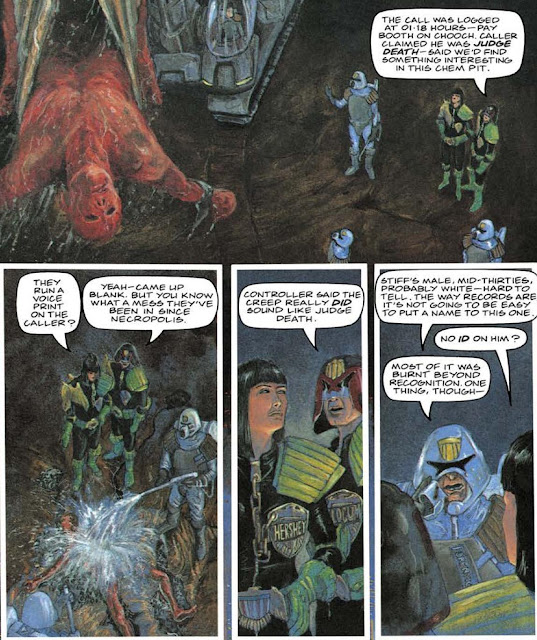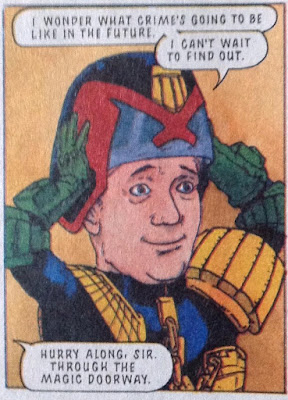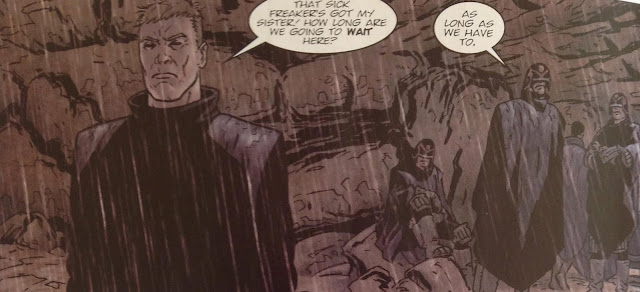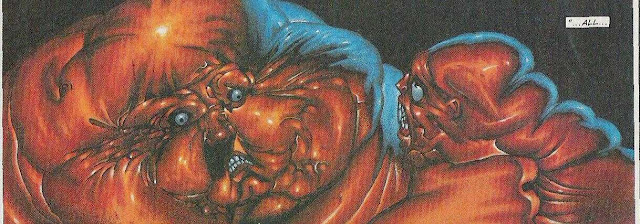First Prog: 766 (cover and strip)
Latest Prog: 1995
(colours); 1957 (strip art)
First Meg: 1
Latest Meg: 341
 |
| Doherty was one of the few post-McCarthy artists on Dredd to embrace that radical triangular helmet / shiny look. Words by John Wagner |
Total appearances: 104
-including a couple of
lettering credits on his own art, and an ever-increasing handful of colouring
credits. I gather health prevents him from doing very much drawing, which is a
massive shame
Creator Credits:
Young Death
Breathing Space
Other art credits:
Judge Dredd
Armitage
Devlin Waugh
As single Terror Tale, and a
one-off for Crisis
Notable character creations:
Sidney D’Eath* (and his demon
dentist dad)
Mrs Gunderson
Ratfink
Notable characteristics:
Generating palpable
atmosphere, usually of the urban horror variety: dreary, hopeless, downtrodden,
chilly and infused with dread. Also characters with pointy noses and chins
(except when they have no chin at all), beady eyes, sinister affect, skin that
doesn’t quite fit. And, in among all this, a facility with comedy – often the
kind of comedy that comes from everything being so horrible. Doherty has almost
exclusively worked in the world of Dredd, which is kind of all about people
living in a society that is at root pretty unpleasant.
 |
| A comic story, but the oppressive atmosphere of Mega City 1 oozes through Words by Chris Standley |
On Peter:
Doherty’s first work
was technically on an issue of Crisis (I’m afraid I don’t have it)
– but for me, and I imagine most readers, his true
launch was super high-profile, bursting onto the page in the very first issue
of the Judge Dredd Megazine, with Young
Death. Although America
is the story everyone turns to and talks about now, at the time I recall Young Death being the more hyped series
– not least because it had an obvious hook, namely the secret origin of Judge
Death. Certainly before the Meg actually came out, this was the story that made
me want to buy it.
 |
| A must buy cover! |
Now, there are many
who’d argue that this same series is the very one that’s guilty of turning
Death from a truly horrifying character into a comedy character. The series is
often played for laughs, with the evil dentist and of course dear old Mrs
Gunderson. But I think it’s ripe for re-evaluation as something seriously
sinister. Not least in the light of the recent Deadworld series, the bleakest thing ever, but also, arguably, a
spin-off from Young Death (via Anderson: Half-Life).
Whatever you think of
the script (I didn’t love it at the time, but find I warm to it more and more
on subsequent re-reads), it certainly allowed a new artist the chance to show
what he could do. In terms of the painting, he’s got the atmosphere pretty much
perfect from page 1:
 |
| What a way to launch your career, with an acid-dissolved body being hoisted out of a pit! Words by John Wagner |
But when it comes to
people, he’s still, to an extent, learning on the job. I find it makes his work
especially human, even with his tendency to depict a rather exaggerated version
of humans (often as rather weaselly). Something about Doherty’s style, even
now, sort of allows you to imagine him drawing them on the page. I can picture
him using a very sharp, thin pencil to sketch out a bug-eyed loser coming to a
sticky end…
 |
| The fear is all in the whites of the eyes... |
For all the roughness
around the edges, Doherty’s cartooning instincts are immaculate.
 |
| While poor Brian Skuter enters the dreadful chill of Death's room, Mrs Gunderson indulges in some slapstick Words by John Wagner |
By the end of the
twelve issue run, he was largely fully-formed. His work since then has improved
and improved, but the essence hasn’t changed, to my eyes. It’s its own thing,
and unlike anything else. And of course there’s that magic ingredient about
Doherty’s artwork - it always elevates whatever script it’s attached to.
 |
| Ah, the delights up the 'up the nose, staring at the gums' panel. Doherty at his nastiest... Words by John Wagner |
Case in point: Justice One. The story lingers in my
memory as a minor classic, even though the murder mystery at its heart never
quite lived up to the premise and the setting, and above all, the super
atmospheric art.
 |
| Actually, I can't remember if this is from Justice 1, but it's an awesome panel of carnage. |
Judgement Day, the next Doherty/Ennis collaboration, has its porblems, one of which is the weird mix of artists that work across the series as a whole. While an Ezquerra solo effort would clearly have worked, I'm kinda sad we didn't get Doherty doing the whole thing. His early, zombie-focussed episodes were some of the best, and it would have lent the whole mega-epic a very different tone from others. Hell, I even liked his 'secret origin of Sabat' Beano-inspired epsiode.
And of course, there's his Johnny Alpha:
Doherty did get to take on a mini-epic by himself, Mechanismo II. It takes the comic violence of MacNeil’s original and turns it into a
tight-knit thriller (kind of like the reverse of the Alien-Aliens transition). Still with comedy.
 |
| How does Doherty make this cover so moody and silly at the same time? |
 |
| More carnage! (In the MacNeil tradition, of course) Words by John Wagner |
Bury my Knee at Wounded Heart - which could, in different circumstances,
have been a well-liked but not especially remembered Ron Smith Dredd from the
80s – ends up as perhaps the single best Dredd episode to grace the Megazine,
and certainly an emotional high-point of the 90s. It even manages to be funny,
too (not least in the ludicrously convoluted pun of the title). In a world where ‘funny’ means feeling angry and sad while laughing. Sure, it's in Wagner's script, but Doherty brings so much to the storytelling:
 |
| This panel hanuts my dreams. So cold! |
 |
| Exploring the banality and extreme importance of death across three panels |
 |
| Dredd apologises, but can't hide his shame. Words for all the above by John Wagner |
There's no real compairons in style (except I guess an overload of wrinkles), but some of this work puts me in mind of John Ridgway, that other master of telling you exactly what his characters are emoting.
Prologue (the unimaginatively titled, but crucially important scene-setter for the Tenth Planet, itself the prologue to
Wilderlands) has this epic exchange**:
 |
| Panel description: 'Hershey looks taken aback, but you can also tell that one of her deeper secrets has just been exposed and she can't quite hide it' Words by John Wagner |
More perfect character
work, no?
Of course, there was
time for pure comedy, too, with the likes of Mr Bennet joins the Judges (not without its dark and sinister
moments)
 |
| A riff on UK children's TV show 'Mr Benn' Words by Mark Millar |
And the All-new Adventures of PJ Maybe, who
always did manage to be a figure of both fun and horror. But this isn’t him, of
course! It’s another in a long line of Dohertyian sadsacks.
Doherty completes (well, almost) his
tour of major Dredd supporting characters with Night School, a tale of Dolman and Vienna, the Dredds who managed to ignore the
call to work in justice dept.
 |
| Words by John Wagner |
And, hopefully not his
Dredd swansong, he got to deliver a brand new and recurring villain, perhaps
the closest Dredd has come to pure nastiness, the sneering, leering Ratfink. If some readers were turned off
by him, it might just be because Doherty did too good of job of realising a
figure that is almost too horrible too look at, let alone spend time inside the
head of. Chilling.
 |
| A sadist enjoying the chase |
 |
| Even the people sent to catch the Ratfink are corrupted by his nastiness. Also, check out that rain! Doherty is the king of foul weather. Words by John Wagner. |
Still within the world
of Dredd, some years earlier, there was Breathing
Space. Sadly Doherty was only able to complete full art for the first two
episodes before ill-health forced him to step back to colours only. But he’d
done more than enough work to set the tone for this very odd noir-ish thriller
that is ultimately about a man having a protracted mental breakdown.
 |
| And this is the opening episode! Words by Rob Williams |
Still technically
within the world of Dredd, but really quite far to one side, Doherty delivered
what remains the most recent outing for Devlin
Waugh, a character he really nails. It’s partly a flashback story, but for
me it’s the homely scenes of Devlin and his mum on the sofa having tea and cake
that just feels really right for the character.
 |
| Devlin's pose in that panel nails the character. Words by John Smith (now write some more, please, Mr Smith!) |
I don’t know if he is just super
picky and won’t take on anything less than Dredd (or his world), or if it’s
just that Tharg finds him super-suited to that world. He did tackle a couple of Sinister Dexter covers; I guess Downlode is probably as horrible a place to live as MC1! Certainly it's not short of mutant weirdoes.
Since then,
significant colouring projects include Mandroid
II, Ichabod Azrael II and recent
3riller Mindmines, his lightest job
yet! I suppose it’s not that his colouring is inherently dark, more that his
subject matter tends to be on the moody side, so this kind of thing sticks out.
 |
| So bright! Words by Rory McConville (a newish droid who must have been over the moon to hear his story was going to be illustrated by Colin MacNeil AND Doherty on colours) |
And maybe it’s right
to end with his most recent bit of strip work, the Terror Tale Night Shifts, a kind of throwback to the
1980s world of monster movies.
 |
| Words by John Smith |
Across a near 30-year
career for Tharg, Doherty hasn’t been as prolific as some, but by gosh what he
has delivered has been from the top drawer of the top chest of drawers.
More on Peter Doherty:
His own blog (sadly
not updated in quite some time)
Another examination ofhis career, looking beyond 2000AD as well
And he’s the subject
of an old episode of the Panel Borders podcast:
Personal favourites:
Young Death
Judge Dredd: Justice One; Moving violation; Mechanismo Returns; Bury my Knee; Ratfink
Breathing Space: the story is flawed (but still good); the art
is terrific.
Devlin Waugh: Innocence and Experience
*Potentially, ‘De’ath’
is just an alias. But it’s all we’ve got! (And it is a real name)
**Which I was
delighted to see checked in the History of Female Judges series; check it out
for thoroughness and fascinating insights!








































